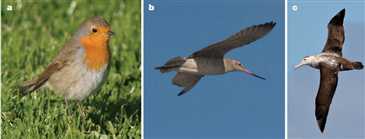标签:navigate rate enable 需要 grant ted read stop rev
摘要:For centuries, humans have been fascinated by how migratory animals find their way over thousands of kilometres. Here, I review the mechanisms used in animal orientation and navigation with a particular focus on long-distance migrants and magnetoreception. I contend that any long-distance navigational task consists of three phases and that no single cue or mechanism will enable animals to navigate with pinpoint accuracy over thousands of kilometres. Multiscale and multisensory cue integration in the brain is needed. I conclude by raising twenty important mechanistic questions related to long-distance animal navigation that should be solved over the next twenty years.
如何下的结论?可信性如何?如何实验证明?你又不是鸟 怎知鸟的机理 身体构造
几个世纪以来,人类一直着迷于迁徙动物是如何在数千公里之外找到它们的路的。在这里,我回顾了动物定向和导航中使用的机制,特别关注远距离迁徙和磁接收(particularly focus on)。我认为,任何远程导航任务都由三个阶段组成,没有任何单一的提示或机制能够使动物在数千公里的范围内精确导航。大脑需要多尺度和多感官的线索整合。最后,我提出了20个与远程动物导航相关的重要机械问题,这些问题将在未来20年内得到解决。
each year, billions of small songbirds (Fig. 1a), with ‘birdbrains’ weighing only a few grams, leave their Arctic and temperate breeding areas to overwinter in the tropics and subtropics. Most migrate at night, and young birds do so without regular contact with experienced individuals. Thus, their navigational capabilities must be innate or learned before their first departure1–5. After having completed one round trip, many adult birds are able to navigate with an ultimate precision of centimetres over distances of 5,000 km or more6. Other impressive navigational tasks mastered by birds include bar-tailed godwits (Limosa lapponica, Fig. 1b) migrating from Alaska to New Zealand in a single non-stop flight lasting 7–9 days and nights 7, arctic terns (Sterna paradisaea) breeding around the North Pole and wintering around the South Pole8, and sea-birds (Fig. 1c) flying more than 100,000 km per year to return to tiny islands in the middle of vast oceans to breed9,10
每年,数十亿只“鸟脑”只有几克重的小型鸣禽(图1a)离开北极和温带繁殖区,在热带和亚热带越冬。大多数在夜间迁徙,幼鸟在没有与有经验的个体定期接触的情况下也会这样做。因此,他们的导航能力必须是天生的或在第一次出发前就学会的。成一次往返飞行后,许多成年鸟类能够在5000公里或更长的距离内以厘米的终极精度进行导航。其他令人印象深刻的由鸟类掌握的导航任务,包括斑尾塍鹬(Limosa Lapponica,图1b)从阿拉斯加迁移到新西兰的单程不间断飞行,持续7-9天昼夜不停,北极燕鸥(Sterna Paradisea)在北极繁殖,在南极过冬,和海鸟(图1c)飞行超过每年10万公里,返回大洋中部的小岛繁殖。

Even insects with much simpler brains than birds are capable of performing impressive navigational tasks11–18. In autumn, Monarch but-terflies (Danaus plexippus, Fig. 1d) migrate from the USA and Canada to very specific overwintering trees in Mexico, up to 3,000 km away11. A year later, the third-to-fifth-generation descendants of the previous year’s autumn migrants return to the exact same trees in Mexico11. A similarly impressive return migration—but involving only a single gen-eration—occurs in Southeast Australia, where millions of Bogong moths (Agrotis infusa, Fig. 1e) fill the night skies on their way to and from their yearly aestivation caves in the Snowy Mountains18. Recently, Chapman et al.17,19,20 demonstrated that directed long-distance return migrations are also widespread among high-flying insects. These movements of trillions of individual insects are critical for understanding both natural and man-made ecosystems21.
Long-distance navigation and magnetoreception in migratory animals(迁徙动物中的长距离导航和磁感应)
标签:navigate rate enable 需要 grant ted read stop rev
原文地址:https://www.cnblogs.com/2008nmj/p/10263319.html